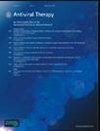利匹韦林联合核苷/核苷酸逆转录酶抑制剂治疗HIV-1感染患者的长期安全性和有效性:336周2b期和3项临床研究的滚动研究
IF 2.3
4区 医学
Q4 INFECTIOUS DISEASES
引用次数: 0
摘要
背景评估非核苷逆转录酶抑制剂利匹韦林(RPV)与核苷/核苷酸逆转录酶抑制剂(NRTI)联合治疗人类免疫缺陷病毒(HIV)感染患者的长期安全性和有效性。方法来自2b期或3期研究的RPV治疗的HIV感染患者转入该3期开放标签研究,并接受RPV 25mg,每日一次(QD),选择两种NRTI。评估不良事件(AE)、血浆病毒载量、CD4+细胞计数和抗病毒耐药性。结果在482名接受治疗的患者中,437名(>90%)患者停止了研究治疗;371人(77%)改用市售RPV,14人(2.9%)因AE停用,6人(1.2%)出现病毒学失败。在这项滚动研究中,患者被随访至336周,尽管数据仅限于288周以上。截至当前分析数据截止时(2018年2月8日),仍有四十五名(9.3%)患者在接受治疗。最常报告的AE是7例(1.5%)妊娠患者和5例(1.0%)梅毒患者。17名(3.5%)患者报告了3-4级AE,23名(4.8%)患者报告的AE可能与RPV有关。在288周的治疗中,80.1%(95%置信区间:74.9%;84.3%)的患者保持了病毒学抑制(HIV-1 RNA<50拷贝/mL)。绝对CD4+细胞计数随着时间的推移而增加,直到第192周,并且此后保持恒定。结论RPV 25 mg QD与研究者选择的两种NRTI的背景方案相结合显示出持续的长期病毒学抑制。该治疗耐受性良好,没有新的安全性发现。本文章由计算机程序翻译,如有差异,请以英文原文为准。
Long-term safety and efficacy of rilpivirine in combination with nucleoside/nucleotide reverse transcriptase inhibitors in HIV-1 infected patients: 336-week rollover study of phase 2b and 3 clinical studies
Background To evaluate the long-term safety and efficacy of rilpivirine (RPV), a non-nucleoside reverse transcriptase inhibitor (NNRTI), in combination with nucleoside/nucleotide reverse transcriptase inhibitors (NRTIs) in human immunodeficiency virus (HIV)–infected patients. Methods RPV-treated HIV-infected patients from phase 2b or 3 studies rolled-over into this phase 3, open-label study and received RPV 25 mg once daily (QD) with choice of two NRTIs. Adverse events (AEs), plasma viral load, CD4+ cell count, and antiviral resistance were evaluated. Results Of the 482 patients treated, 437 (>90%) patients discontinued study treatment; 371 (77%) had switched to commercially available RPV, 14 (2.9%) discontinued due to AEs, and 6 (1.2%) had virologic failure. In this rollover study, patients were followed up to week 336, although data was limited beyond 288 weeks. Forty-five (9.3%) patients were still undergoing treatment at the time of data cut-off for the current analysis (8 February 2018). The most frequently reported AEs were pregnancy in 7 (1.5%) patients and syphilis in 5 (1.0%) patients. Grade 3–4 AEs were reported in 17 (3.5%) patients, and AEs possibly related to RPV in 23 (4.8%) patients. Over 288 weeks of treatment, 80.1% (95% CI: 74.9%; 84.3%) of patients maintained virologic suppression (HIV-1 RNA <50 copies/mL). The absolute CD4+ cell count increased over time until week 192 and remained constant thereafter. Conclusions RPV 25 mg QD in combination with an investigator-selected background regimen of two NRTIs demonstrated sustained long-term virologic suppression. The treatment was well-tolerated with no new safety findings.
求助全文
通过发布文献求助,成功后即可免费获取论文全文。
去求助
来源期刊

Antiviral Therapy
医学-病毒学
CiteScore
2.60
自引率
8.30%
发文量
35
审稿时长
4-8 weeks
期刊介绍:
Antiviral Therapy (an official publication of the International Society of Antiviral Research) is an international, peer-reviewed journal devoted to publishing articles on the clinical development and use of antiviral agents and vaccines, and the treatment of all viral diseases. Antiviral Therapy is one of the leading journals in virology and infectious diseases.
The journal is comprehensive, and publishes articles concerning all clinical aspects of antiviral therapy. It features editorials, original research papers, specially commissioned review articles, letters and book reviews. The journal is aimed at physicians and specialists interested in clinical and basic research.
 求助内容:
求助内容: 应助结果提醒方式:
应助结果提醒方式:


